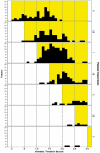The primary type of tremor in essential tremor is kinetic rather than postural: cross-sectional observation of tremor phenomenology in 369 cases
- PMID: 22925197
- PMCID: PMC3511652
- DOI: 10.1111/j.1468-1331.2012.03855.x
The primary type of tremor in essential tremor is kinetic rather than postural: cross-sectional observation of tremor phenomenology in 369 cases
Abstract
Background: Essential tremor (ET) is amongst the most commonly misdiagnosed neurological diseases. The current aim was to provide observational data on a basic characteristic of ET, namely, the relative severity of postural to kinetic tremor.
Methods: A total of 369 ET cases were enrolled in a cross-sectional study. Postural tremor scores (0-3) and kinetic tremor scores (0-3) were assigned during a standardized neurological examination.
Results: In the vast bulk of cases (~95%), kinetic tremor was more severe than postural tremor. In nearly one-in-three cases (32.8%), the kinetic tremor score was ≥ 1 points higher than the postural tremor score. Conversely, in only a few cases (~5%) was postural tremor even marginally (<1 point) more severe than kinetic tremor, and in no case was the postural tremor score ≥ 1 point higher than the kinetic tremor score. At each postural tremor score, nearly all cases had that amount of kinetic tremor or more.
Conclusion: The primary type of tremor in ET is kinetic rather than postural. Recognition of the simple, empirical features of tremor phenomenology has potential diagnostic value for practicing clinicians.
© 2012 The Author(s) European Journal of Neurology © 2012 EFNS.
Figures

References
-
- Benito-Leon J, Bermejo-Pareja F, Morales JM, Vega S, Molina JA. Prevalence of essential tremor in three elderly populations of central Spain. Mov Disord. 2003;18:389–394. - PubMed
-
- Jain S, Lo SE, Louis ED. Common misdiagnosis of a common neurological disorder: how are we misdiagnosing essential tremor? Arch Neurol. 2006;63:1100–1104. - PubMed
-
- Martinelli P, Gabellini AS, Gulli MR, Lugaresi E. Different clinical features of essential tremor: a 200-patient study. Acta Neurol Scand. 1987;75:106–111. - PubMed
-
- Brennan KC, Jurewicz EC, Ford B, Pullman SL, Louis ED. Is essential tremor predominantly a kinetic or a postural tremor? A clinical and electrophysiological study. Mov Disord. 2002;17:313–316. - PubMed
Publication types
MeSH terms
Grants and funding
LinkOut - more resources
Full Text Sources
Medical

